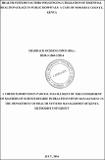| dc.description.abstract | Availability of health care services does not guarantee that patients will optimally use them. In Homabay County, lack of access to health services is among the top reasons for low service utilization. This study focused on service delivery pillar and in particular the utilization of essential health packages (EHP), which include infectious diseases, maternal and newborn health, nutritional deficiencies and common injuries. According to Kenya Demographic Health Survey 2014, the health care utilization rate is 77% for those who are sick in Kenya. Among those who are ill and do not seek care, 44% and 18% were hindered by cost and distance respectively. The Health Sector Statistics Report also suggests that the overall child mortality rate is 121 per 1,000 live births. In Homabay County, child mortality rate is 91 per 1,000 live births, and maternal mortality rate is 583 per 100,000, compared to the national average of 488 per 100,000. The study assessed health systems factors influencing the utilization of EHP in public hospitals in Homabay County. Specifically, the study assessed how human resources for health, availability of drug, the role of health infrastructure, and organizational practices influence the utilization of EHP. The study adopted cross-sectional research design. Two hospitals were conveniently sampled (Homa-bay County Hospital and Mbita Sub-County Hospital) due to their large volume of patients. Yamane's formula was used determine the respondents' sample size. The study used stratified and simple random sampling methods to sample 138 health workers (Pharmacists 5, Clinicians 13, Health Management Information System Officers 8, Nurses 104, and Hospital Managers 8), and simple random sampling to sample 186 patients. Structured questionnaire and key interview guide (with 8 hospital heads) were used to collect data. Findings revealed that, all the health workers 138 (100%) said that Homabay County has shortage of health workers, the hospitals have inadequate drugs and patients are referred elsewhere due to lack of medical equipment. Majority 115 (83.3%) health workers say hospitals lack operational ambulances. Majority 153 (82.3%) and 135 (72.6%) of patients are hindered by cost and distance respectively to access health care. Among organizational factors, majority 159 (85.5%) patients do not always find all services they wanted and had ever failed to seek care because of the long waiting time. The regression model revealed at least 0.06 coefficients, indicating that a positive change in the independent variables (human resources for health, availability of drugs and supplies, health infrastructure, and organizational practices) results in a positive change in the dependent variable, utilization of EHP. Positive Pearson's correlation of 0.11 showed a close relationship between the variables. Conclusively, Homabay County lacks adequate health workers, drugs and hospital infrastructure, in addition to poor organizational practices leading to low utilization of EHP. The study recommends that the county employs more health workers, improves the procurement system, invests on health infrastructure including medical equipment, emergency ambulances, and buildings and should review costs of services to improve utilization of EHP in Homabay County. | en_US |

